Photo
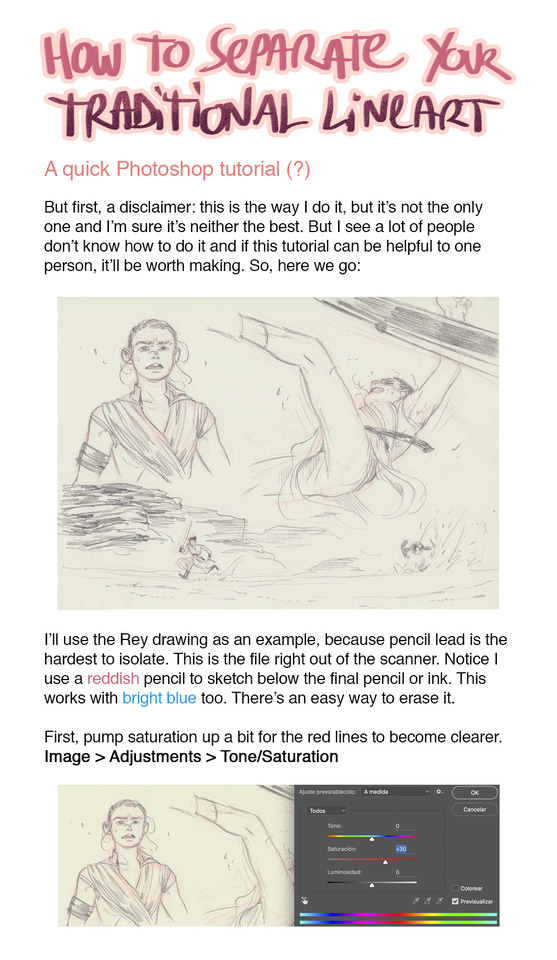
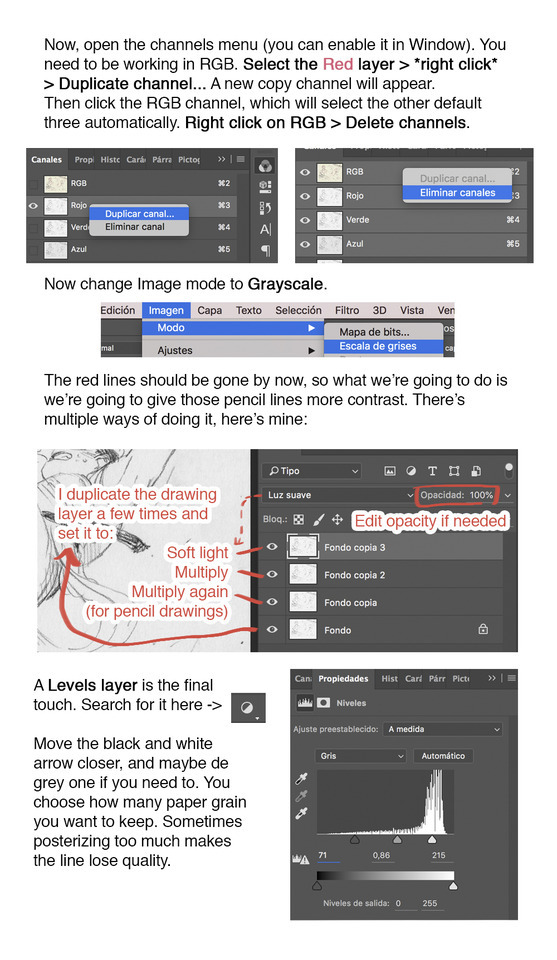
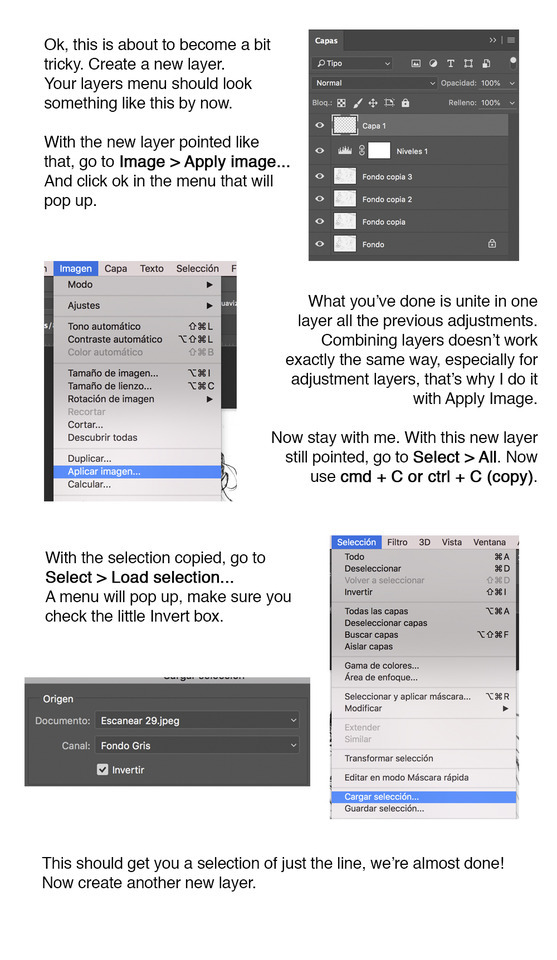
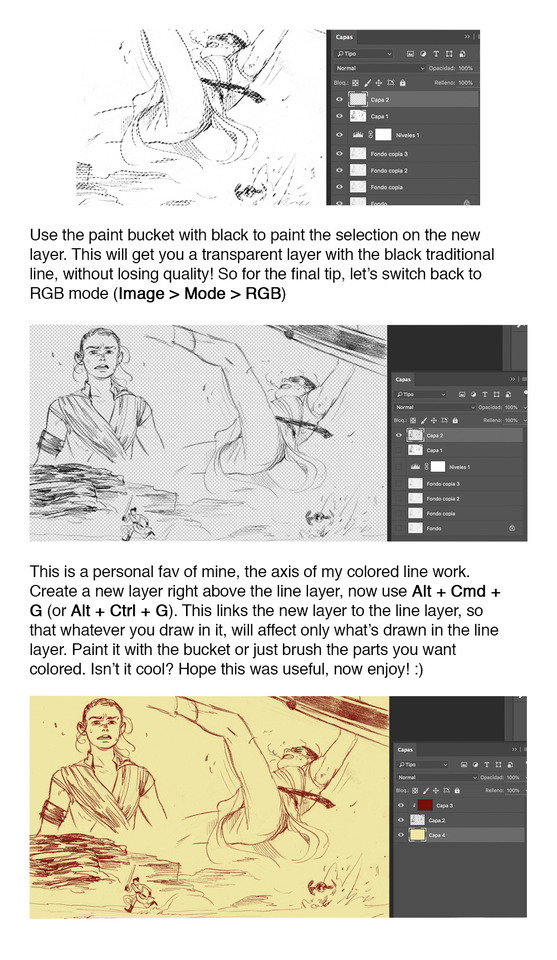
People keep asking about this from time to time, so here is this little tutorial. I explained the best I could :,) Keep in mind this is just one way of doing it, and maybe you can change some of the steps to find one that works better for you. Hope it’s useful to someone out there!
1K notes
·
View notes
Photo

I’m obsessed with drawing smoke because there’s just something so soothing about it? So here’s a tutorial no one asked for, hope it helps someone!
751 notes
·
View notes
Photo

“I Receive Good News Soon”
Write this sigil on paper, kiss it, and then burn it outside on a Sunday
3K notes
·
View notes
Photo



As an artist, you’ll have to draw turned heads countless times. But when the head is turned, drawing the far eye poses a special challenge. This is because we must foreshorten that eye more than we’re used to, and because we’re tempted to shape it like the near eye, which is less foreshortened. Therefore, it’s useful to practice drawing the far eye by itself, without the near eye to throw you off. Print these sheets, draw the eyes, and you’ll save yourself great difficulty later.
Note that all of these eyes are facing our left. You’ll need to practice right-facing eyes as well, so flop the sheets in Photoshop, print them again, and draw those also.
14K notes
·
View notes
Note
What's that keypad thing next to your tablet? It looks cool!
It’s actually a USB numpad that I reprogrammed to use as a Photoshop hotkey/shortcut pad! There’s an entire tutorial here on how to do it.
But I ended up doing this because with the way my work area is set up, it’s much easier to have all my shortcuts close to my left hand while I’m drawing with my right hand, instead of having to reach over to use the keyboard.

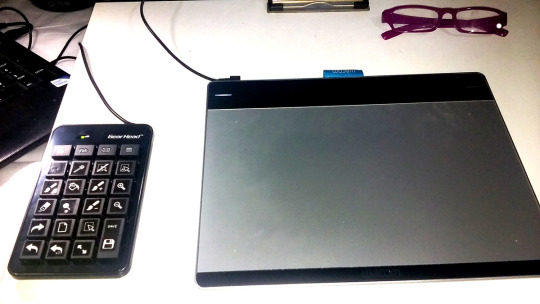
I bought the numpad at my local computer store on clearance for $6 (regular price was $10) and the sticker paper for $4 at Wal-Mart (it’s actually 8.5″ x 11″ shipping labels). The tutorial I provided above already has everything you need to make one of these keypads yourself, including the sticker files, so it only cost me $10 to make mine. Compare that to the brand name programmable hotkey pads (like X-Keys) that cost $100+!!
It’s very useful and I highly recommend doing it if you find yourself frustrated with your work station (like having to reach over your tablet for your keyboard).
One thing I suggest tho that the tutorial left out, is that when you print the stickers out, make sure you put strips of scotch tape over the printed image before you cut them out, that way the ink won’t rub off from your fingers touching them on the keys all the time.
10K notes
·
View notes
Photo

WIP of one of my OCs, Hel. Working on movement and detail with this one.
#art#artists on tumblr#female artists#original characters#original character#oc#oc art#oc artwork#character design
12 notes
·
View notes
Video
youtube
The Ugly Painting Phase • Working through Art Problems
♥ Super helpful video on getting over that point in your art where you feel stuck and unhappy with the work you’re doing and it REALLY helped me out so I wanted to share it on here. Love this artist! This video was great!♥
353 notes
·
View notes
Text
@ Artists who are working non-art-related jobs while making art on your time off
-You are an artist no matter what, and I am SO HAPPY that you are employed and able to also have time to do what you love.
-If you’re doing this as a transitional thing and hope to move to art-related work eventually, that is AWESOME. It’s a great plan, and it is super normal. Keep workin’ on that portfolio/skillset and building those connections, my friend. SO many of my friends worked various jobs between college and industry work.
-If you want to keep art as a hobby and don’t want to ever work professionally as an artist, that is a wonderful decision to make that is probably totally right for you! That’s fantastic that you’re able to figure out what YOU need as an artist! You are still an artist! You don’t ever need to do professional work as an artist to be an artist. I wish you all the luck in your non-art-related career and hope art continues to bring you joy as a passion.
-If you want to do some professional art work (such as freelance or commissions / selling prints and working conventions) but also want to have a separate career outside of art, hey, that sounds like an awesome plan too! You can be a professional in more than one field at once!
There isn’t one way to be an artist. I know I constantly answer questions about getting into the animation industry or working as a professional, but that doesn’t mean Im espousing that as the “correct path”. I just mostly get questions about those topics. There is no correct path as an artist. If you make art, you’re an artist. Period.
3K notes
·
View notes
Link
I like how this article explains different tactics for each platform, which operate differently.
I don’t think social media is everything, but when your art is your business, a strong social media game is necessary.
I encourage you to view the links at the bottom to see the different places you can share your work with the @art-res community!
Thanks for reading! If this post helped, please consider reblogging it or sharing it with your friends! ❤️
More useful articles and resources / support Art-Res | my art tumblr | Idea Generator | Check out the Art-Res Anatomy Ebook!
334 notes
·
View notes
Link
What a beautiful walkthrough!
Very neat way of combining media, both traditional and digital.
Thanks for reading! If this post helped, please consider reblogging it or sharing it with your friends! ❤️
More useful articles and resources / support Art-Res | my art tumblr | Idea Generator | Check out the Art-Res Anatomy Ebook!
184 notes
·
View notes
Text
Commission Pricing 101
Guidelines for Setting Commission Prices
Article by @dragonofdarknesschaos
article dated April 25th 2017
Original Source: [x]
I’m going to be blunt with all'y'all. You are most likely under-pricing your work. That’s okay, but please consider the following:
——————————————————————
Industry Standard Price List for Book Illustration*
Black and White:
• Spread: $500-$1500
• Full Page: $500-$9500
• Quarter Page: $100-$350
Color:
• Spread: $700-$2000
• Full Page: $500-$1500
• Quarter Page: $200-$400
*From The Handbook of Pricing and Ethical Guidelines by the Graphic Artists Guild, ed. 13–basically the bible for all visual artists looking to sell and price their work. Check your local library for a copy.
——————————————————————
Not all artists are comfortable charging this much for their work, or maybe feel that their work isn’t good enough to charge more than a few bucks (if anything at all), some are just doing it for fun and don’t care about the money so much.
All of that is okay. Individual commissioners usually don’t have the kind of money to drop that large corporations do.
This is more about setting a few guidelines to prevent people from charging pennies for a full-color spread.
See below:
——————————————————————
Fandom’ Average Price List
Black and White:
• Spread: $10-$50
• Full Page: $5-$30
• Quarter Page: $5-$30
Color:
• Spread: $50-$200
• Full Page: $20-$70
• Quarter Page: $10-$30
Valuing Your Work
If you don’t value your time, no one else will.
——————————————————————
You probably put a lot of time and effort into your work over the months or even years that you’ve been honing your craft. So even if you’re in the select few who can actually bang out a beautiful piece of art in twenty minutes or less, think about how long it took you to get to that point. I knew I wanted to do art professionally since the age of four; at the time of this writing I’ve gained 21 years of experience. Not all of it was paid or professional quality work, but I learned and grew to what I am now. Even if you’ve only been drawing a few months, that time and experience matters all the same! Don’t sell your skills short.
Now that you’ve gained some confidence in your abilities, it’s time to set a monetary value for your skills. Usually artists go with an hourly rate. This means that for however many hours you work on a piece, you charge the commissioner (or customer) by the amount you set. THE COMMISSIONER DOES NOT NEED TO KNOW HOW LONG IT TAKES YOU TO MAKE THE ARTWORK. DO, however, ask when they need the artwork by. If you cannot complete the artwork in that amount of time asked, turn down the commission or find out if the deadline can be changed.
Let’s try this hourly rate in an example now.
Say it takes three hours to do a full color bust and the hourly rate is $10.
In math terms it’s…
(hourly rate) x (time spent) = (amount to charge).
The artist would charge $30 for the full-color bust commission.
Thirty dollars for just a drawing of a head and shoulders might seem like a lot, and one might be tempted to decrease the hourly rate so the amount to charge is within those ‘Fandom’ Averages mentioned above.
Doing the same work for a total of $5 means one would charge $1.67 hourly.
Most states have minimum wages well above that.
Are you worth less than the bare minimum, or are you worth more?
Spoiler alert–YOU MATTER!! And so does your artwork too!
If you’re still not feeling confident enough, just look up your state’s minimum wage and use that for your hourly rate. You can then slowly raise your prices as you gain more confidence in your work. While people might complain, remind them–and yourself–about those Industry Standard Prices listed above.
It doesn’t hurt to let your fans know that you will be increasing your prices in advance either!
——————————————————————
When to Increase Your Prices
Either increase your prices when you feel confident in doing so, when there’s simply too much demand for your work, or if you’ve been undervaluing yourself.
Increasing the price will deter some potential customers, but those who sincerely want your work will save up to commission you no matter what.
Those are the people you want to work with.
If the demand is still too high for you to keep up, or you don’t feel comfortable increasing prices to keep up with demand, create slots, or a short list of commissions you are currently working on.
Create a wait list too, if that helps. Just maintain a clear path of communication with your supporters.
——————————————————————
The Nuances of Pricing
If you really want to get technical, there’s going to be MORE MATH ahead. Though it’s basically all about breaking down how much time it takes you to do anything.
It will take you three times longer than you think it will.
——————————————————————
Pricing by Style
Wow, you can actually draw in multiple styles!? GREAT! AMAZING! Not everyone can do that.
If it takes you more time to draw one style than another have a price chart that clearly shows that.
If you have multiple coloring styles or techniques, break down how long each takes and give prices based on that.
Dissect your artistic process into steps if that helps to understand what to charge for. Creating steps like this will also help if (and when) you need to make invoices, or lists of the services you’re providing for billing purposes.
The following are examples of pricing broken down into each step in an artistic process for two vastly different styles:
Super Cartoony Style (full page):
- sketch: $10 x 15mins (or .25hr) = $2.50
- lines: $10 x 90mins (or 1.5hrs) = $15.00
- color: $10 x 1hr = $10
- (no shading)
Total: $27.50
Semi-Realistic Painterly Style (full page):
- sketch: $10 x 1hr = $10
- (no lines)
- color: $10 x 2hrs = $20
- shading: $10 x 6hrs = $60
Total: $70
Having these kinds of breakdowns will help potential commissioners identify what they want and what they can afford.
Yeah, that’s great, but what if someone just wants a sketch in the Super Cartoony Style? Then I’m making less than those ‘Fandom’ Average prices!
True, but what if you sit down to do the sketch commission, and instead of taking fifteen minutes, you end up spending twenty minutes looking up reference of the character, and the poses you want, end up scrapping a bunch of attempts, and before you know it, an hour and a half has passed? By then you’ve charged the commissioner for fifteen minutes of work when it actually took you six times longer. If this happens to you consistently, consider switching to a flat-rate approach or compensate for this time difference in the prices you offer.
——————————————————————
Flat Rate Pricing
Essentially you charge more up front and lower the price of any additional steps. As such, additional services, like lines, color, and shading are then smaller fees that get tacked on after the preliminary sketch is completed.
The flat rate is typically based on the average amount of time it takes to do each step of the process.
Say it takes anywhere from 15-90 minutes to do a sketch depending on how inspired you are.
With the same hourly rate of $10, that’s a range of $2.50-$15.
Depending on complexity things might take longer, so let’s bump it up to $20 just to be safe.
Keeping the total costs the same as for the hourly break downs above results in the following:
Super Cartoony Style (full page) flat rate:
- sketch: $20
- lines: $4
- color: $3.50
- (no shading)
Total: $27.50
Semi-Realistic Painterly Style (full page) flat rate:
sketch: $30
(no lines)
color: $15
shading: $25
Total: $70
There’s less actual math involved, but it means that you’ll at least get your money’s worth whether you spend the fifteen minutes you originally allotted, or wind up taking two hours.
Again, the commissioner doesn’t need to know how long it actually took you to make the art.
Consider adjusting the flat rates if you find yourself spending more time on certain things than your hourly rate covers.
In the example, if you repeatedly spend more than two hours on a sketch, then you need to increase your initial rate to compensate.
This model also plays a bit into the ideas behind the “super size” marketing.
For just four dollars more you get cleaner line art. For only three and a half dollars more you get full color! If a commissioner can get over the initial price to start, chances are they’ll be more willing to spend the few extra dollars to get a higher level of finish.
——————————————————————
Methods of Payment
While DeviantArt is a great place for finding and getting commissions, they don’t exactly have the best monetary system in place.
Here are a few other methods you can use.
While there are other sites and services you can use to send money, be sure both the artist and commissioner have agreed on the amount due and payment method before sending anything.
In general do not start on the artwork until at least half of the payment is received or processed.
——————————————————————
The Commissions Widget (on DeviantArt)
Pros:
easy to use
built into site
allows points to be turned into actual cash
Cons:
deducts 20% from your earnings (most sites charge less than 10%)
keeps points earned from commissions separate from total points
few people have 3,000 points to drop
If you’re intent on using this system, be sure to add a 20% tax to your final cost
(e.g. $27.50 + ($27.50 x .2) = $33.00 or 3,300 points)
While you could simply trade the points outside the commissions widget, the points cannot [legally] be turned back into cash.
——————————————————————
Google Wallet
Pros:
easy to use
works fast
no usage fee
Cons:
open to continental US ONLY
requires gmail account
no invoices
If you already have a gmail account, then you automatically have access to gwallet. It’s just a matter of connecting a bank account or credit card then.
While there are no invoices for any money exchanges that I’m aware of, still consider making invoices for your records.
——————————————————————
PayPal
Pros:
internationally available
used across many sites for payment
very secure
has built-in invoices
Cons:
lots of rules that constantly change and are difficult to understand
difficult to navigate; if done incorrectly one may be charged
both parties must fill out forms correctly or the artist will be charged or have their account banned
If you live inside or outside the continental US, here are a few links that may be helpful in [writing those invoices], and [making sure you don’t get burned].
Also do not use PayPal to send your art, as their rules are a bit convoluted about who owns the rights to the artwork then.
——————————————————————
Patreon
Pros:
easy to understand
processes payments through Amazon
allows creators to build communities around their projects
multiple price points can be offered at the same time
encourages repeat customers
Cons:
while it’s a bit daunting to get set up and situated, Patreon has an almost infinite amount of easy to understand resources to help their creators take off
though not necessary, it helps to have a strong social media presence elsewhere
smaller group of commissioners
For those who don’t know, Patreon is like KickStarter, but it recurs monthly, and it’s just for creatives.
What I’ve seen most artists who do commissions exclusively through Patreon do is have a lower reward tier that is fan driven like monthly requests, in addition to a higher reward tier that is the actual commission button so-to-speak.
This format kind of forces the flat rate pricing method to an extreme, so price well, or create a dialogue with your fans/patrons/potential commissioners to see what they’re most interested in getting for their money.
They might even give you ideas for projects to do down the road.
——————————————————————
TL;DR
Professional illustrations go for 20-50 times MORE than what most ‘fandom’ artists charge.
Value your time, or else no one else will. This means that you deserve to work for above minimum wage.
Never tell the commissioner how long it takes to make your artwork (unless you need more time to make your artwork).
It’s OKAY to increase your prices. Especially if there’s high demand for your work.
You can price by how long it takes you to do each step of your artistic process OR…
You can have a higher flat rate to do the first step of your process, with smaller, additional fees for finishes like color, or shading, or both.
Be transparent about what you’re charging for.
There are many sites and methods of payment, use the one that is most convenient for both parties.
USE. INVOICES. No matter how simple.
If you DO decide to use dA’s Commission Widget, charge a 20% tax to cover the site’s cut.
Trust yourself–after all, these commissioners came to you for your unique art style! You can’t go wrong by doing you.
Anyone is welcome to ask further questions, or suggest additions.
Article by @dragonofdarknesschaos
article dated April 25th 2017
Original Source: [x]
16K notes
·
View notes
Text
Fusion Request Rules
I am creating this post to ensure there are no misunderstandings when I say you may message me for a fusion request.
- I may or may not participate depending on my schedule or log of art I am currently working on.
- A request is you asking me to use my gemsona for a fusion that you want to draw. You are essentially asking my permission to use my design in your artwork.
- You must credit me in any posts featuring the artwork involving my gemsona.
- I do not allow NSFW content of my gems or any fusions with them.
- I reserve the right to decline any request at any time for any reason.
0 notes
Text
Contemplating offering commissions...
I need more income. I make enough right now to only pay my bills, and sometimes it's a close call. If I could make even an extra $200 a month through commissions, that would be a huge help.
Anyone have any advice for first time commission-takers? I've read blogs and posts about it, but I want to make sure I'm covering all my bases.
My most important questions are:
- What is the most effective way to market commissions? Should I create separate formats for Twitter, Instagram, Tumblr and so on?
- Tips and tricks for avoiding commission horror stories?
- Best practices for the process of the commission itself? (Sketches, previews, etc)
6 notes
·
View notes
Photo





This month’s gemsona prompt, Tranquillityite. I decided to place her within Yellow Diamond’s court with the idea that her position/task was to help members of the court with relaxing de-stressing.
Ko-fi: Faderoot
Twitter: @erinvaltinson
DO NOT REMOVE CAPTIONS OR REPOST WITHOUT MY PERMISSION.
#monthly gem challenge#gemsona november prompt#gemsona#gemsonas#fangem#fangems#fan gem#su oc#su gemsona#su fangem#steven universe#steven universe fan art#steven universe gems#steven universe gemsona#original characters#original character#artists on tumblr#my art#myart#tranquillityite
58 notes
·
View notes
Photo



Covellite - A gem of new beginnings and new discoveries. Known for insight, self discovery, and communication among many other things. Covellite is a member from a collective of gems known as Seeker Mirrors.
Feel free to DM if you’re interested in doing a fusion!
Ko-fi.com/faderoot
Twitter.com/ErinValtinson
Art only blog: tumblr.com/fade-root
DO NOT REMOVE CAPTIONS. DO NOT REPOST WITHOUT MY PERMISSION.
143 notes
·
View notes
Photo

I’m not sure when I’ll actually finish coloring this. #artistsoninstagram #myart #characterdesign #pink #gemsona
https://www.instagram.com/p/Bp_Qai1Bwer/?utm_source=ig_tumblr_share&igshid=kz8q1oc581y4
#my art#steven universe gemsona#steven universe gems#steven universe fan art#steven universe#gemsonas#fan gem#crystal gems#gemsona#fangem
18 notes
·
View notes
Photo



Bloodshot Iolite (also known as Iolite Sunstone.) A fanfusion between two of my gems, Euclase and Rainbow Moonstone and Garnet from the CGs.
Ko-Fi // Art Only Blog
#gemsona#gemsonas#fangem#fan gem#fan fusion#fanfusion#steven universe#steven universe gemsona#steven universe gems#steven universe fan fusion#steven universe fanfusion#steven universe fan art#steven universe garnet#my art#artists on tumblr#fan art#fanart
571 notes
·
View notes